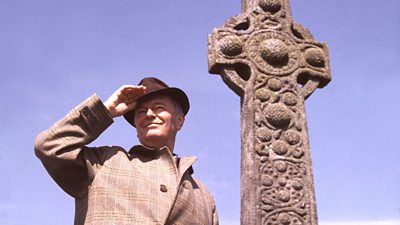First broadcast in 1969 across 13 episodes, Civilisation took viewers on a tour through 13 countries and back through many centuries, all guided by Lord Kenneth Clark as he expounded, with characteristic enthusiasm and astonishing erudition, his thoughts on European civilisation as it is revealed through the development of art.
A true milestone in television documentary, Civilisation set the template for so many epic series written and presented by trusted authors and experts since – establishing a familiar format that endures on television today. And its influence has by no means been restricted to arts programming - Civilisation’s pioneering example can be felt in programmes on subjects as varied as natural history, science, history and, yes, art.
Creating Civilisation
A confluence of factors led to the creation of the series that would prove to be the blueprint for so much of the television that followed. As David Attenborough tells it in this clip, in his then-role as controller of ���˿��� Two, he was looking for a showcase for colour television – something that would bring great works of art into the homes of the viewing public.
Sir Kenneth Clark had previously risen to public prominence in his role as Director of the National Gallery and had a longstanding interest in broadcasting, having been the Chair of the Independent Television Authority. His extraordinary knowledge was matched by his talent for communicating and his passion for doing so. For Clark there was no snobbery around the medium of television, and he had made several series on art for ATV (including the wonderfully titled Is Art Necessary?). But the prospect of Civilisation was something quite different – here was the opportunity to present a personal thesis on the story of European art and civilisation in depth and on an unprecedented scale. Clark explains some of the ideas and motivations behind the series to presenter Joan Bakewell, in this episode of Late Night Line Up that was broadcast in the same week as the first episode of the series.
What made Civilisation different from previous series on art and philosophy was its expanded format, both in length and in ambition. The series would not only show great works of art, but Clark would endeavour to define their meaning to history and western culture. It was always billed as ‘a personal view by Kenneth Clark’ and he devoted as much time and effort to the creation of the programme as he did to the writing of his books. Here Stephen Hearst, responsible for Television Arts Features at the time of Civilisation, explains the precedent this set:
The aesthetics of Civilisation
Attenborough’s ambition for the series gave an extra dimension to this, Clark’s thoughts and selected works of art would not merely be illustrated, but would be shot on location in colour and on 35mm film. With most arts series confined to studios or 16mm black and white film, Civilisation would have extra aesthetic appeal.
Working on Civilisation were producers and directors Michael Gill and Peter Montagnon. Gill and Montagnon had previously worked together on ���˿��� Schools Programmes and one can see the educational influence at play in Civilisation with its clear strategy to both show and tell the viewer Clark’s thoughts on the eras and works in each episode.
In addition, played a key role in how the programme looked. Turner had previously worked on the ���˿���’s magazine-format arts series Monitor, where thoughtful and innovative programming on arts was the order of the day. The challenge presented by Civilisation was of a different scale, and it was Turner’s responsibility to arrange the wrangling of the enormous 35mm cameras to capture still works of art. The use of 35mm meant that the camera work in the series was rather still, yet the quality of the images captured and the colour is part of what makes Civilisation so beautiful and captivating even today.

Filming on location was key to bringing audiences closer to the art, architecture and monuments that Clark was discussing, and episodes brought the viewers right along with him from Skellig Michael to New York via Florence.
Critical and public reaction
Civilisation was immediately met with critical acclaim and audience adoration, and was heralded as a landmark of television. International sales meant the series was shown all over the world, and it attracted particular attention in America, where it was shown on PBS.
Authored documentary series’ such as Alistair Cooke’s America (1972) and Jacob Bronowski’s The Ascent of Man (1973) soon followed, with David Attenborough’s Life on Earth (1979) coming a little later. Today, large-scale documentary programmes built around a single presenter, including those by Professor Brian Cox and Dr Lucy Worsley, all owe a debt to the format created by Civilisation.
But as much as the ���˿��� had paved the way with Civilisation, all programme making is necessarily of the moment and reflective of its time. Even in 1969 however, there was some uneasiness about the focus of Civilisation. Stanley Reynolds, writing in The Guardian, noted “Each week since February Sir Kenneth has been talking to us about the men who have made civilisation… it is one sort of man, almost at times it has seemed like the same man, that Sir Kenneth has been talking about.” Professor David Hendy has described Civilisation as “unashamedly patrician” and for all its qualities, its tight focus remained resolutely limited to the works of white men from a handful of countries.
The shift to Civilisations
With those criticisms in mind, in 2018 the ���˿��� presented Civilisations – a series inspired by Clark’s original, but taking a more international view and with a multi-authored perspective. Civilisations was written and presented by Professor Mary Beard, Professor David Olusoga and Professor Simon Schama – all of whom had previously made their own authored series in the mould of Civilisation. Here the presenters explain the irresistible challenge of making the programme –
This new series was shot in 31 countries, over six continents, giving the audience a global perspective and the key to the plural that made the new programme about civilisations rather than a single notion of civilisation. We now expect television to bring us the whole world, and with it different perspectives on that world. Reflecting the reach and accessibility of the modern ���˿���, beyond its television broadcast, Civilisations was accompanied by the Civilisations festival, related television programmes, radio programmes, podcasts and an app. It was also produced in partnership with the Open University.
It could be argued that this widening of access is the modern equivalent of shooting in colour in the late 1960s. What we understand ‘television’ to be is now so much wider and more varied than it was in 1969.Nearly 50 years after Clark’s original series, Civilisations brought its spirit of bold ambition into modern times. We can only speculate as to what form a third series made in 2068 might take, and what scope it might cover.
Written by Lisa Kerrigan, senior curator of television at the BFI National Archive, and curator for the BFI project Visions of Change: TV Documentary of the 1950s-1960s. She also led the BFI team that compiled the recent .
Further reading
Jonathan Conlin, Civilisation (BFI TV Classics), 2009
Mary Irwin, Civilisation and the Rise of the Television Blockbuster Documentary. Journal of British Cinema and Television, July 2017, vo. 14, No. 3

